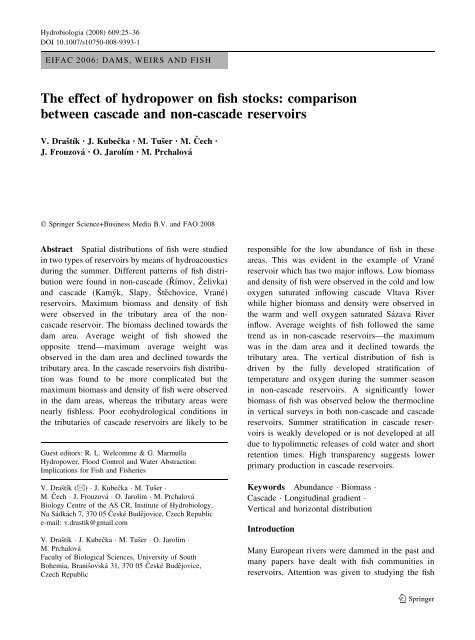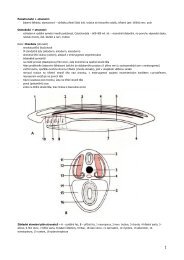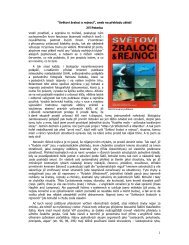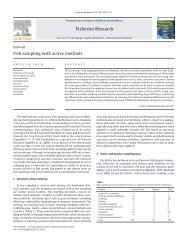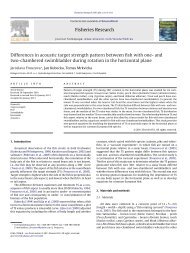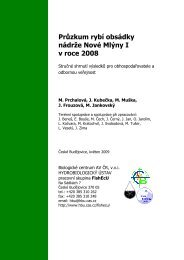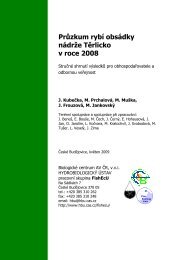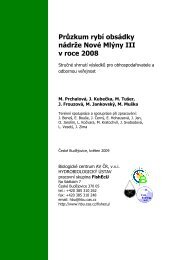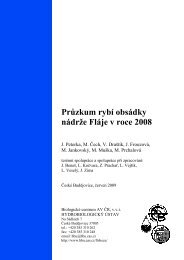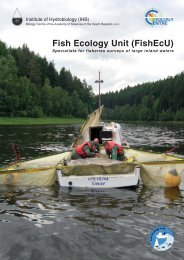The effect of hydropower on fish stocks: comparison between ...
The effect of hydropower on fish stocks: comparison between ...
The effect of hydropower on fish stocks: comparison between ...
You also want an ePaper? Increase the reach of your titles
YUMPU automatically turns print PDFs into web optimized ePapers that Google loves.
Hydrobiologia (2008) 609:25–36<br />
DOI 10.1007/s10750-008-9393-1<br />
EIFAC 2006: DAMS, WEIRS AND FISH<br />
<str<strong>on</strong>g>The</str<strong>on</strong>g> <str<strong>on</strong>g>effect</str<strong>on</strong>g> <str<strong>on</strong>g>of</str<strong>on</strong>g> <str<strong>on</strong>g>hydropower</str<strong>on</strong>g> <strong>on</strong> <strong>fish</strong> <strong>stocks</strong>: comparis<strong>on</strong><br />
<strong>between</strong> cascade and n<strong>on</strong>-cascade reservoirs<br />
V. Draštík Æ J. Kubečka Æ M. Tušer Æ M. Čech Æ<br />
J. Frouzová Æ O. Jarolím Æ M. Prchalová<br />
Ó Springer Science+Business Media B.V. and FAO 2008<br />
Abstract Spatial distributi<strong>on</strong>s <str<strong>on</strong>g>of</str<strong>on</strong>g> <strong>fish</strong> were studied<br />
in two types <str<strong>on</strong>g>of</str<strong>on</strong>g> reservoirs by means <str<strong>on</strong>g>of</str<strong>on</strong>g> hydroacoustics<br />
during the summer. Different patterns <str<strong>on</strong>g>of</str<strong>on</strong>g> <strong>fish</strong> distributi<strong>on</strong><br />
were found in n<strong>on</strong>-cascade (Římov, Želivka)<br />
and cascade (Kamýk, Slapy, Štěchovice, Vrané)<br />
reservoirs. Maximum biomass and density <str<strong>on</strong>g>of</str<strong>on</strong>g> <strong>fish</strong><br />
were observed in the tributary area <str<strong>on</strong>g>of</str<strong>on</strong>g> the n<strong>on</strong>cascade<br />
reservoir. <str<strong>on</strong>g>The</str<strong>on</strong>g> biomass declined towards the<br />
dam area. Average weight <str<strong>on</strong>g>of</str<strong>on</strong>g> <strong>fish</strong> showed the<br />
opposite trend—maximum average weight was<br />
observed in the dam area and declined towards the<br />
tributary area. In the cascade reservoirs <strong>fish</strong> distributi<strong>on</strong><br />
was found to be more complicated but the<br />
maximum biomass and density <str<strong>on</strong>g>of</str<strong>on</strong>g> <strong>fish</strong> were observed<br />
in the dam areas, whereas the tributary areas were<br />
nearly <strong>fish</strong>less. Poor ecohydrological c<strong>on</strong>diti<strong>on</strong>s in<br />
the tributaries <str<strong>on</strong>g>of</str<strong>on</strong>g> cascade reservoirs are likely to be<br />
Guest editors: R. L. Welcomme & G. Marmulla<br />
Hydropower, Flood C<strong>on</strong>trol and Water Abstracti<strong>on</strong>:<br />
Implicati<strong>on</strong>s for Fish and Fisheries<br />
V. Draštík (&) J. Kubečka M. Tušer <br />
M. Čech J. Frouzová O. Jarolím M. Prchalová<br />
Biology Centre <str<strong>on</strong>g>of</str<strong>on</strong>g> the AS CR, Institute <str<strong>on</strong>g>of</str<strong>on</strong>g> Hydrobiology,<br />
Na Sádkách 7, 370 05 České Budějovice, Czech Republic<br />
e-mail: v.drastik@gmail.com<br />
V. Draštík J. Kubečka M. Tušer O. Jarolím <br />
M. Prchalová<br />
Faculty <str<strong>on</strong>g>of</str<strong>on</strong>g> Biological Sciences, University <str<strong>on</strong>g>of</str<strong>on</strong>g> South<br />
Bohemia, Branišovská 31, 370 05 České Budějovice,<br />
Czech Republic<br />
resp<strong>on</strong>sible for the low abundance <str<strong>on</strong>g>of</str<strong>on</strong>g> <strong>fish</strong> in these<br />
areas. This was evident in the example <str<strong>on</strong>g>of</str<strong>on</strong>g> Vrané<br />
reservoir which has two major inflows. Low biomass<br />
and density <str<strong>on</strong>g>of</str<strong>on</strong>g> <strong>fish</strong> were observed in the cold and low<br />
oxygen saturated inflowing cascade Vltava River<br />
while higher biomass and density were observed in<br />
the warm and well oxygen saturated Sázava River<br />
inflow. Average weights <str<strong>on</strong>g>of</str<strong>on</strong>g> <strong>fish</strong> followed the same<br />
trend as in n<strong>on</strong>-cascade reservoirs—the maximum<br />
was in the dam area and it declined towards the<br />
tributary area. <str<strong>on</strong>g>The</str<strong>on</strong>g> vertical distributi<strong>on</strong> <str<strong>on</strong>g>of</str<strong>on</strong>g> <strong>fish</strong> is<br />
driven by the fully developed stratificati<strong>on</strong> <str<strong>on</strong>g>of</str<strong>on</strong>g><br />
temperature and oxygen during the summer seas<strong>on</strong><br />
in n<strong>on</strong>-cascade reservoirs. A significantly lower<br />
biomass <str<strong>on</strong>g>of</str<strong>on</strong>g> <strong>fish</strong> was observed below the thermocline<br />
in vertical surveys in both n<strong>on</strong>-cascade and cascade<br />
reservoirs. Summer stratificati<strong>on</strong> in cascade reservoirs<br />
is weakly developed or is not developed at all<br />
due to hypolimnetic releases <str<strong>on</strong>g>of</str<strong>on</strong>g> cold water and short<br />
retenti<strong>on</strong> times. High transparency suggests lower<br />
primary producti<strong>on</strong> in cascade reservoirs.<br />
Keywords Abundance Biomass <br />
Cascade L<strong>on</strong>gitudinal gradient <br />
Vertical and horiz<strong>on</strong>tal distributi<strong>on</strong><br />
Introducti<strong>on</strong><br />
Many European rivers were dammed in the past and<br />
many papers have dealt with <strong>fish</strong> communities in<br />
reservoirs. Attenti<strong>on</strong> was given to studying the <strong>fish</strong><br />
123
26 Hydrobiologia (2008) 609:25–36<br />
<strong>stocks</strong> after the reservoir was built and comparis<strong>on</strong><br />
with their recent state (Gido et al., 2000; Matthews<br />
et al., 2004). Several authors have also studied the<br />
impact <str<strong>on</strong>g>of</str<strong>on</strong>g> reservoirs <strong>on</strong> river fauna (Poddubny &<br />
Galat, 1995; Gido et al., 2002a; Falke & Gido, 2006).<br />
Patterns <str<strong>on</strong>g>of</str<strong>on</strong>g> <strong>fish</strong> species compositi<strong>on</strong> in different<br />
reservoirs have been reported by Irz et al. (2002);<br />
Argillier et al. (2002a); Argillier et al. (2002b);<br />
Godinho et al. (1998); Godinho et al. (1997) and<br />
the successi<strong>on</strong> <str<strong>on</strong>g>of</str<strong>on</strong>g> <strong>fish</strong> communities in reservoirs in<br />
Central Europe has been summarized by Kubečka<br />
(1993). <str<strong>on</strong>g>The</str<strong>on</strong>g> majority <str<strong>on</strong>g>of</str<strong>on</strong>g> reservoirs in Central Europe<br />
are eutrophic and their <strong>fish</strong> communities are dominated<br />
by cyprinid species which represent a climax<br />
state in reservoir successi<strong>on</strong>. Cascade reservoirs have<br />
received very little attenti<strong>on</strong> so far, but there are some<br />
indicati<strong>on</strong>s that the patterns <str<strong>on</strong>g>of</str<strong>on</strong>g> successi<strong>on</strong> are different<br />
in such reservoirs due to limitati<strong>on</strong>s <strong>on</strong> the<br />
spawning <str<strong>on</strong>g>of</str<strong>on</strong>g> cyprinids (Hanel & Čihař, 1983;<br />
Hrbáček, 1984; Hanel, 1988; Draštík et al., 2004).<br />
Only a few authors have investigated <strong>fish</strong> communities<br />
al<strong>on</strong>g a l<strong>on</strong>gitudinal pr<str<strong>on</strong>g>of</str<strong>on</strong>g>ile <str<strong>on</strong>g>of</str<strong>on</strong>g> the reservoir<br />
(Siller et al., 1986; Świerzowski et al., 2000; Vašek<br />
et al., 2003, 2004). <str<strong>on</strong>g>The</str<strong>on</strong>g> aim <str<strong>on</strong>g>of</str<strong>on</strong>g> this study was to<br />
describe the spatial distributi<strong>on</strong> <str<strong>on</strong>g>of</str<strong>on</strong>g> <strong>fish</strong> al<strong>on</strong>g the<br />
l<strong>on</strong>gitudinal pr<str<strong>on</strong>g>of</str<strong>on</strong>g>iles <str<strong>on</strong>g>of</str<strong>on</strong>g> reservoirs and compare them<br />
within two reservoir groups with different ecohydrology—n<strong>on</strong>-cascade<br />
and cascade reservoirs. Vertical<br />
distributi<strong>on</strong>s <str<strong>on</strong>g>of</str<strong>on</strong>g> the <strong>fish</strong> were also studied. This article<br />
attempts to answer the questi<strong>on</strong>s: (a) is there any<br />
comm<strong>on</strong> pattern <str<strong>on</strong>g>of</str<strong>on</strong>g> <strong>fish</strong> distributi<strong>on</strong> and (b) is the<br />
pattern <str<strong>on</strong>g>of</str<strong>on</strong>g> <strong>fish</strong> distributi<strong>on</strong> general or does it differ<br />
<strong>between</strong> different kinds <str<strong>on</strong>g>of</str<strong>on</strong>g> reservoirs?<br />
Materials and methods<br />
Two n<strong>on</strong>-cascade and four cascade reservoirs were<br />
chosen for this study <str<strong>on</strong>g>of</str<strong>on</strong>g> the spatial distributi<strong>on</strong> <str<strong>on</strong>g>of</str<strong>on</strong>g> <strong>fish</strong>.<br />
N<strong>on</strong>-cascade reservoirs have no <str<strong>on</strong>g>hydropower</str<strong>on</strong>g> <str<strong>on</strong>g>effect</str<strong>on</strong>g><br />
from a dam upstream. Římov and Želivka are<br />
cany<strong>on</strong>-shaped mezo- to eutrophic, n<strong>on</strong>-cascade reservoirs<br />
(Fig. 1). Kamýk, Štěchovice and Vrané<br />
reservoirs (all \300 ha) and Slapy Reservoir<br />
([1,000 ha; for detailed informati<strong>on</strong> see Hrbáček,<br />
1984) are located immediately <strong>on</strong>e after <strong>on</strong>e and form<br />
a reservoir cascade <strong>on</strong> the Vltava River. <str<strong>on</strong>g>The</str<strong>on</strong>g> characteristics<br />
<str<strong>on</strong>g>of</str<strong>on</strong>g> the reservoirs are shown in Table 1.<br />
Inflowing water to all cascade reservoirs is released<br />
from hypolimnetic layers and its temperature and<br />
saturati<strong>on</strong> by oxygen is low. C<strong>on</strong>sidering Vrané<br />
reservoir, two rivers flow in to the reservoir: the<br />
Vltava River with the hypolimnetic water released<br />
from upstream reservoirs and the Sázava River with<br />
eutrophic water (Fig. 1). Each reservoir was divided<br />
into four separate areas (or five if the reservoir has a<br />
sec<strong>on</strong>d important tributary): tributary, upper, middle<br />
and dam areas. Upper, middle and dam areas refer to<br />
lentic c<strong>on</strong>diti<strong>on</strong>s. Tributary refers partly to lotic<br />
c<strong>on</strong>diti<strong>on</strong>s in that area.<br />
Routine acoustic surveys were carried out during<br />
daytime in late summer 2004—Římov Reservoir 9<br />
August, Želivka Reservoir 15–16 August; cascade<br />
reservoirs 31 August–7 September. A Simrad EY500<br />
split-beam echosounder, operating <strong>on</strong> frequency<br />
120 kHz, was used with two transducers mounted<br />
in fr<strong>on</strong>t <str<strong>on</strong>g>of</str<strong>on</strong>g> the boat: an elliptical transducer (ES120_4,<br />
nominal beam angles 9.1 9 4.3°) beaming horiz<strong>on</strong>tally<br />
and a circular transducer (ES120_7C, nominal<br />
beam 7 9 7°) surveying vertically. <str<strong>on</strong>g>The</str<strong>on</strong>g> system was<br />
calibrated using a tungsten-carbide sphere (Foote<br />
et al., 1987). All the reservoirs are cany<strong>on</strong>-shaped<br />
and all their l<strong>on</strong>gitudinal pr<str<strong>on</strong>g>of</str<strong>on</strong>g>iles were sampled using<br />
a zig-zag trajectory where the width <str<strong>on</strong>g>of</str<strong>on</strong>g> the valley<br />
allowed it. All the surveys were divided into transects<br />
with different lengths, so that for every reservoir, 50–<br />
100 transects with independent estimates <str<strong>on</strong>g>of</str<strong>on</strong>g> biomass,<br />
density and average <strong>fish</strong> weight were available. Total<br />
volumes sampled are given in Table 1. Biomass and<br />
density analysis was performed with S<strong>on</strong>ar 5 postprocessing<br />
s<str<strong>on</strong>g>of</str<strong>on</strong>g>tware (Balk & Lindem, 2005). All <strong>fish</strong><br />
were automatically tracked then manually c<strong>on</strong>firmed.<br />
Minimum track length was set to 3 and maximal ping<br />
gap set to 1 as the parameters for the tracker. For<br />
every <strong>fish</strong> track, average target strength (ts see<br />
Simm<strong>on</strong>ds and Mac Lennan, 2005) was calculated.<br />
For calculating density <str<strong>on</strong>g>of</str<strong>on</strong>g> <strong>fish</strong> (in individuals ha -1 )<br />
the sv/ts approach was used with a scaling factor<br />
(average ts, see Balk & Lindem, 2005; Simm<strong>on</strong>ds and<br />
Mac Lennan, 2005) derived from tracked <strong>fish</strong>. ts<br />
noise thresholds were -60 dB for both the horiz<strong>on</strong>tal<br />
and vertical surveys. <str<strong>on</strong>g>The</str<strong>on</strong>g> horiz<strong>on</strong>tal surveys covered<br />
the first 4 m below the surface (surveyed range <str<strong>on</strong>g>of</str<strong>on</strong>g> a<br />
sidescan was 4–30 m), while the vertical survey<br />
covered the rest <str<strong>on</strong>g>of</str<strong>on</strong>g> the water column to the bottom<br />
([4 m). Fish length was calculated from ts using the<br />
relati<strong>on</strong>ships <str<strong>on</strong>g>of</str<strong>on</strong>g> Frouzová et al. (2005) and assuming<br />
dorsal aspect in vertical records and random<br />
123
Hydrobiologia (2008) 609:25–36 27<br />
Fig. 1 Locati<strong>on</strong>s <str<strong>on</strong>g>of</str<strong>on</strong>g> the<br />
reservoirs studied and their<br />
sequence in a cascade.<br />
Black and white colours<br />
distinguish <strong>between</strong><br />
different localities<br />
(T—tributary, U—upper,<br />
M—middle and D—dam<br />
area) in each reservoir; grey<br />
represents the Sázava arm<br />
(S) in Vrané Reservoir.<br />
Black arrows indicate the<br />
directi<strong>on</strong> <str<strong>on</strong>g>of</str<strong>on</strong>g> flow in the<br />
reservoir. Be aware <str<strong>on</strong>g>of</str<strong>on</strong>g><br />
different scale—the size <str<strong>on</strong>g>of</str<strong>on</strong>g><br />
each reservoir is shown in<br />
Table 1<br />
distributi<strong>on</strong> <str<strong>on</strong>g>of</str<strong>on</strong>g> <strong>fish</strong> in the horiz<strong>on</strong>tal plane (Kubečka<br />
et al., 1994). Fish lengths were c<strong>on</strong>verted to weights<br />
using length–weight relati<strong>on</strong>ships (<strong>fish</strong> from the<br />
Římov reservoir, unpublished data) and the biomass<br />
was obtained by multiplying average weight and<br />
density. Summer stratificati<strong>on</strong> was measured by a<br />
calibrated ISY 556 MPS probe in at least three places<br />
al<strong>on</strong>g the l<strong>on</strong>gitudinal axis <str<strong>on</strong>g>of</str<strong>on</strong>g> each reservoir.<br />
Transparency was measured by Secchi disk at the<br />
same places. Differences in the spatial distributi<strong>on</strong> <str<strong>on</strong>g>of</str<strong>on</strong>g><br />
<strong>fish</strong> al<strong>on</strong>g the l<strong>on</strong>gitudinal axes <str<strong>on</strong>g>of</str<strong>on</strong>g> the reservoirs were<br />
tested by <strong>on</strong>e-way ANOVA and comparis<strong>on</strong> <str<strong>on</strong>g>of</str<strong>on</strong>g><br />
vertical distributi<strong>on</strong>s <str<strong>on</strong>g>of</str<strong>on</strong>g> <strong>fish</strong> was tested by two-way<br />
ANOVA in STATISTICA s<str<strong>on</strong>g>of</str<strong>on</strong>g>tware, versi<strong>on</strong> 6. Tukey<br />
HSD post hoc comparis<strong>on</strong>s were used for detailed<br />
identificati<strong>on</strong> <str<strong>on</strong>g>of</str<strong>on</strong>g> significantly different localities.<br />
123
28 Hydrobiologia (2008) 609:25–36<br />
Table 1 <str<strong>on</strong>g>The</str<strong>on</strong>g> basic characteristics <str<strong>on</strong>g>of</str<strong>on</strong>g> n<strong>on</strong>-cascade and cascade<br />
reservoirs studied in the Czech Republic—year <str<strong>on</strong>g>of</str<strong>on</strong>g> filling, area,<br />
volume, maximum depth, average retenti<strong>on</strong> time (RT), summer<br />
average <str<strong>on</strong>g>of</str<strong>on</strong>g> chlorophyll a (Chl a), sampled volume (Samp. vol.)<br />
and maximal daily water level fluctuati<strong>on</strong> (WLF)<br />
Reservoir<br />
Year <str<strong>on</strong>g>of</str<strong>on</strong>g><br />
filling<br />
Area (ha)<br />
Volume<br />
(mil. m 3 )<br />
Max.<br />
depth<br />
(m)<br />
RT<br />
(days)<br />
Chl a<br />
(lg l -1 )<br />
Samp. vol.<br />
(mil. m 3 )<br />
mWLF<br />
(m)<br />
Římov 1978 210 34.5 43.9 130.0 45.0 5.4 0.1<br />
Želivka 1976 1,432 246.0 55.7 424.0 10.8 34.5 0.1<br />
Kamýk 1963 195 12.1 14.5 1.8 18.0 1.2 1.0<br />
Slapy 1955 1,392 269.3 58.0 38.5 30.0 23.6 0.5<br />
Štěchovice 1945 115 11.2 20.6 1.5 3.5 0.9 4.0<br />
Vrané 1935 251 11.1 10.2 1.2 40.0 1.0 0.5<br />
Results<br />
N<strong>on</strong>-cascade reservoirs<br />
<str<strong>on</strong>g>The</str<strong>on</strong>g> spatial distributi<strong>on</strong> <str<strong>on</strong>g>of</str<strong>on</strong>g> <strong>fish</strong> in both n<strong>on</strong>-cascade<br />
reservoirs showed a clear pattern. Estimates <str<strong>on</strong>g>of</str<strong>on</strong>g> mean <strong>fish</strong><br />
biomass and density al<strong>on</strong>g the reservoirs were significantly<br />
different am<strong>on</strong>g the areas examined in both the<br />
Římov reservoir (Fig. 2a, b; biomass F = 3.94,<br />
d.f. = 3, P = 0.01; density F = 33.27, d.f. = 3,<br />
P \ 10 -6 ) and the Želivka reservoir (Fig. 3a, b;<br />
biomass F = 4.55, d.f. = 3, P = 0.01; density<br />
F = 19.13, d.f. = 3, P \ 10 -6 ). <str<strong>on</strong>g>The</str<strong>on</strong>g> highest <strong>fish</strong><br />
density and biomass revealed by the horiz<strong>on</strong>tal surveys<br />
was observed in the tributary area <str<strong>on</strong>g>of</str<strong>on</strong>g> both reservoirs.<br />
Tributary area were significantly different from upper<br />
(P = 0.045) and middle (P = 0.016) areas in <strong>fish</strong><br />
biomass and from upper, middle and dam areas in <strong>fish</strong><br />
density (all P = 0.02). Fish biomasses and densities<br />
estimated by vertical surveys in the n<strong>on</strong>-cascade<br />
reservoirs seem to be <str<strong>on</strong>g>of</str<strong>on</strong>g> little significance because <strong>on</strong>ly<br />
small numbers <str<strong>on</strong>g>of</str<strong>on</strong>g> <strong>fish</strong> were observed in the deeper layers<br />
(below the thermocline, Table 2) <str<strong>on</strong>g>of</str<strong>on</strong>g> a few transects.<br />
Biomass estimates were higher in the horiz<strong>on</strong>tal surveys<br />
than in the vertical surveys <str<strong>on</strong>g>of</str<strong>on</strong>g> both n<strong>on</strong>-cascade<br />
reservoirs (Želivka F = 10.80, d.f. = 1, P = 0.001;<br />
Římov F = 45.32, d.f. = 1, P \ 10 -6 ). Fish density<br />
was not significantly different but it was slightly higher<br />
in the horiz<strong>on</strong>tal survey than in the vertical survey. <str<strong>on</strong>g>The</str<strong>on</strong>g><br />
size <str<strong>on</strong>g>of</str<strong>on</strong>g> the <strong>fish</strong> shows a clear pattern in Římov reservoir<br />
(Fig. 4). <str<strong>on</strong>g>The</str<strong>on</strong>g> estimate <str<strong>on</strong>g>of</str<strong>on</strong>g> the average <strong>fish</strong> weight varied<br />
significantly am<strong>on</strong>g the four areas (F = 10.83, d.f. = 3,<br />
Fig. 2 Observed mean<br />
biomass (a) and density (b)<br />
<str<strong>on</strong>g>of</str<strong>on</strong>g> <strong>fish</strong> in the n<strong>on</strong>-cascade<br />
reservoir Římov revealed<br />
by horiz<strong>on</strong>tal acoustics.<br />
Significant differences were<br />
found <strong>between</strong> areas. Error<br />
bars represents standard<br />
deviati<strong>on</strong>s (SD)<br />
Fig. 3 Observed mean<br />
biomass (a) and density (b)<br />
<str<strong>on</strong>g>of</str<strong>on</strong>g> <strong>fish</strong> in the n<strong>on</strong>-cascade<br />
reservoir Želivka revealed<br />
by horiz<strong>on</strong>tal acoustics.<br />
Significant differences were<br />
found <strong>between</strong> areas. Error<br />
bars represents standard<br />
deviati<strong>on</strong>s (SD)<br />
123
Hydrobiologia (2008) 609:25–36 29<br />
Table 2 Average biomass and density <str<strong>on</strong>g>of</str<strong>on</strong>g> <strong>fish</strong> revealed by horiz<strong>on</strong>tal and vertical acoustic surveys <str<strong>on</strong>g>of</str<strong>on</strong>g> the reservoirs listed<br />
Horiz<strong>on</strong>tal<br />
Vertical<br />
Biomass Density Biomass Density<br />
Average SD Average SD Average SD Average SD<br />
Želivka 110.3 148.9 849 1,437 26.0 93.1 698 885<br />
Římov 216.3 162.3 2,186 2,673 0.2 0.3 2,520 3,141<br />
Kamýk 214.8 601.2 449 487 1.0 2.9 330 467<br />
Slapy 194.4 340.3 3,100 6,748 5.7 21.6 2,343 6,304<br />
Štěchovice 39.9 40.5 1,323 1,516 2.4 8.4 216 356<br />
Vrané 37.5 94.6 1,293 2,433 0.2 1.1 143 443<br />
Fig. 4 Mean average weight <str<strong>on</strong>g>of</str<strong>on</strong>g> <strong>fish</strong> in different areas <str<strong>on</strong>g>of</str<strong>on</strong>g><br />
Římov reservoir. Significant differences were found <strong>between</strong><br />
areas. Error bars represents standard deviati<strong>on</strong>s (SD)<br />
P \ 10 -6 ). <str<strong>on</strong>g>The</str<strong>on</strong>g> estimated average weight was highest<br />
in the dam area and lowest in the tributary. <str<strong>on</strong>g>The</str<strong>on</strong>g> dam area<br />
differed significantly from tributary and upper areas<br />
(P = 0.037, P = 0.003 reps.) and the middle area<br />
differed from the upper area (P = 0.02). Estimates <str<strong>on</strong>g>of</str<strong>on</strong>g><br />
the average weight did not differ significantly am<strong>on</strong>g<br />
four areas in Želivka reservoir (P [ 0.05) but <strong>fish</strong> in the<br />
tributary area were <str<strong>on</strong>g>of</str<strong>on</strong>g> slightly smaller average weight<br />
than <strong>fish</strong> in other parts <str<strong>on</strong>g>of</str<strong>on</strong>g> the reservoir. <str<strong>on</strong>g>The</str<strong>on</strong>g> high biomass<br />
<str<strong>on</strong>g>of</str<strong>on</strong>g> <strong>fish</strong> in the tributary areas <str<strong>on</strong>g>of</str<strong>on</strong>g> these reservoirs is formed<br />
by high densities <str<strong>on</strong>g>of</str<strong>on</strong>g> small <strong>fish</strong>. Both n<strong>on</strong>-cascade<br />
reservoirs were fully stratified in terms <str<strong>on</strong>g>of</str<strong>on</strong>g> temperature<br />
as well as oxygen. <str<strong>on</strong>g>The</str<strong>on</strong>g> thermocline was developed at a<br />
depth <str<strong>on</strong>g>of</str<strong>on</strong>g> 4 m (Fig. 5). Water transparency was 2 m close<br />
to the dam.<br />
Cascade reservoirs<br />
Kamýk and Štěchovice reservoirs are small, shallow<br />
cascade reservoirs (area\200 ha). Kamýk Reservoir<br />
Fig. 5 Summer stratificati<strong>on</strong> <str<strong>on</strong>g>of</str<strong>on</strong>g> temperature and oxygen in the<br />
dam area <str<strong>on</strong>g>of</str<strong>on</strong>g> Římov reservoir<br />
is located immediately below the large Orlík Reservoir<br />
(2,733 ha, volume 717 mm 3 , depth 72 m). Fish<br />
mainly inhabited the dam area, where several aggregati<strong>on</strong>s<br />
<str<strong>on</strong>g>of</str<strong>on</strong>g> large <strong>fish</strong> occurred. <str<strong>on</strong>g>The</str<strong>on</strong>g> horiz<strong>on</strong>tal survey<br />
revealed most <strong>fish</strong> biomass (F = 4.53, d.f. = 3,<br />
P = 0.01) and density (F = 6.11, d.f. = 3,<br />
P = 0.004) in the dam area (Fig. 6a, b). Fish biomass<br />
and density in the dam area was significantly<br />
different from the tributary, upper and middle areas<br />
(biomass: P = 0.04, P = 0.04, P = 0.02 resp.; density:<br />
P = 0.01, P = 0.03, P = 0.01 resp.). Very few<br />
123
30 Hydrobiologia (2008) 609:25–36<br />
Fig. 6 Observed mean<br />
biomass (a) and density (b)<br />
<str<strong>on</strong>g>of</str<strong>on</strong>g> <strong>fish</strong> in the cascade<br />
Kamýk Reservoir revealed<br />
by horiz<strong>on</strong>tal acoustics.<br />
Significant differences were<br />
found <strong>between</strong> areas. Error<br />
bars represents standard<br />
deviati<strong>on</strong>s (SD)<br />
<strong>fish</strong> were recorded in deeper layers by the vertical<br />
beaming (Table 2); most <str<strong>on</strong>g>of</str<strong>on</strong>g> them again in the dam<br />
area. <str<strong>on</strong>g>The</str<strong>on</strong>g> biomasses estimated by horiz<strong>on</strong>tal and<br />
vertical beaming were significantly different<br />
(F = 4.33, d.f. = 1, P = 0.04). <str<strong>on</strong>g>The</str<strong>on</strong>g> average weight<br />
<str<strong>on</strong>g>of</str<strong>on</strong>g> <strong>fish</strong> was also highest in the dam area (Fig. 7,<br />
F = 4.06, d.f. = 3, P = 0.02). <str<strong>on</strong>g>The</str<strong>on</strong>g> estimated average<br />
<strong>fish</strong> weight in the dam area was significantly<br />
different from the tributary and upper areas<br />
(P = 0.03 for both). <str<strong>on</strong>g>The</str<strong>on</strong>g> reservoir was not stratified<br />
(Fig. 8a) and transparency was 3.5 m.<br />
Fish distributi<strong>on</strong> in Štěchovice Reservoir did not<br />
show any clear pattern. Estimates <str<strong>on</strong>g>of</str<strong>on</strong>g> mean biomass<br />
and density were not significantly different al<strong>on</strong>g the<br />
l<strong>on</strong>gitudinal axis (Fig. 9a, b; P [ 0.05). Estimates <str<strong>on</strong>g>of</str<strong>on</strong>g><br />
biomass (F = 38.49, d.f. = 1, P \ 10 -6 ) and density<br />
(F = 21.6, d.f. = 1, P \ 10 -6 ) were significantly<br />
higher for the horiz<strong>on</strong>tal survey than for the vertical<br />
survey (Table 2). Summer stratificati<strong>on</strong> had not<br />
developed (Fig. 8b) and transparency was 3.5 m.<br />
Slapy Reservoir is a 42 km l<strong>on</strong>g, mezo- to<br />
eutrophic reservoir which is situated in the middle<br />
Fig. 7 Mean average weights <str<strong>on</strong>g>of</str<strong>on</strong>g> <strong>fish</strong> in different areas <str<strong>on</strong>g>of</str<strong>on</strong>g><br />
Kamýk Reservoir. Significant differences were found <strong>between</strong><br />
areas. Error bars represents standard deviati<strong>on</strong>s (SD)<br />
Fig. 8 Temperature and dissolved oxygen pr<str<strong>on</strong>g>of</str<strong>on</strong>g>iles in the small<br />
cascade Kamýk (a) and Štěchovice (b) reservoirs. Summer<br />
stratificati<strong>on</strong> was not developed.<br />
<str<strong>on</strong>g>of</str<strong>on</strong>g> the Vltava river cascade. <str<strong>on</strong>g>The</str<strong>on</strong>g> highest <strong>fish</strong> biomass<br />
(F = 6.26, d.f. = 3, P = 0.001) and density<br />
(F = 5.64, d.f. = 3, P = 0.002) estimates were<br />
found in the dam area (Fig. 10a, b). Fish biomass in<br />
the dam area was significantly different from the<br />
tributary, upper and middle areas (P = 0.02,<br />
P = 0.004, 0.006 resp.). Fish density in dam area<br />
was significantly different from upper and middle<br />
area (P = 0.01 for both). Fish biomass in the<br />
horiz<strong>on</strong>tal survey was higher than that in the vertical<br />
survey (F = 21.05, d.f. = 1, P \ 10 -6 ). <str<strong>on</strong>g>The</str<strong>on</strong>g> reservoir<br />
was not stratified in the tributary area, where the<br />
influence <str<strong>on</strong>g>of</str<strong>on</strong>g> hypolimnetic water from Orlík and<br />
Kamýk reservoirs is apparent, but other parts were<br />
stratified in terms <str<strong>on</strong>g>of</str<strong>on</strong>g> temperature and oxygen c<strong>on</strong>centrati<strong>on</strong><br />
with a thermocline at a depth <str<strong>on</strong>g>of</str<strong>on</strong>g> 8 m<br />
(Fig. 11). Transparency was high in the tributary area<br />
(3.6 m), lower in the dam area (2.6 m) but lowest just<br />
below the plunging point (1.1 m).<br />
Vrané Reservoir is a small, shallow cascade<br />
reservoir with two tributaries (Fig. 1). <str<strong>on</strong>g>The</str<strong>on</strong>g> horiz<strong>on</strong>tal<br />
123
Hydrobiologia (2008) 609:25–36 31<br />
Fig. 9 Observed mean<br />
biomass (a) and density (b)<br />
<str<strong>on</strong>g>of</str<strong>on</strong>g> <strong>fish</strong> in the cascade<br />
Štěchovice Reservoir<br />
revealed by horiz<strong>on</strong>tal<br />
acoustics. No significant<br />
differences were found<br />
<strong>between</strong> areas. Error bars<br />
represents standard<br />
deviati<strong>on</strong>s (SD)<br />
Fig. 10 Observed mean<br />
biomass (a) and density (b)<br />
<str<strong>on</strong>g>of</str<strong>on</strong>g> <strong>fish</strong> in the cascade Slapy<br />
Reservoir revealed by<br />
horiz<strong>on</strong>tal acoustics.<br />
Significant differences were<br />
found <strong>between</strong> areas. Error<br />
bars represents standard<br />
deviati<strong>on</strong>s (SD)<br />
survey revealed the highest <strong>fish</strong> biomass estimate in<br />
the Sázava arm and in the dam area and low biomass<br />
was observed in the tributary and upper area—the<br />
Vltava arm (Fig. 12a; F = 10.53, d.f. = 4,<br />
P \ 10 -6 ). Fish biomass in Sázava arm was different<br />
from all other areas in the reservoir: tributary, upper,<br />
middle and dam (P = 0.01, P = 0.001, P = 0.0001,<br />
P = 0.01 resp.). <str<strong>on</strong>g>The</str<strong>on</strong>g> density <str<strong>on</strong>g>of</str<strong>on</strong>g> <strong>fish</strong> was also high in<br />
the Sázava arm and low in other parts <str<strong>on</strong>g>of</str<strong>on</strong>g> the reservoir<br />
including the dam area (Fig. 12b; F = 3.68, d.f. = 4,<br />
P = 0.01). Fish density in the Sázava arm was<br />
significantly different from the tributary, upper,<br />
middle and dam areas (P = 0.02, P = 0.04,<br />
P = 0.02, P = 0.02 resp.). Fish distributi<strong>on</strong> in the<br />
vertical survey did not vary al<strong>on</strong>g the l<strong>on</strong>gitudinal<br />
axis <str<strong>on</strong>g>of</str<strong>on</strong>g> the reservoir (P [ 0.05). Fish biomass and<br />
density observed by the horiz<strong>on</strong>tal survey was<br />
significantly higher than the density and biomass<br />
from the vertical survey (biomass F = 23.95,<br />
d.f. = 1, P \ 10 -6 ; density F = 42.10, d.f. = 1,<br />
P \ 10 -6 ). <str<strong>on</strong>g>The</str<strong>on</strong>g> average weight <str<strong>on</strong>g>of</str<strong>on</strong>g> <strong>fish</strong> was high in<br />
the dam area and Sázava arm and low in the tributary<br />
and upper part (Fig. 13; F = 4.93, d.f. = 3,<br />
P = 0.002). <str<strong>on</strong>g>The</str<strong>on</strong>g> estimated average <strong>fish</strong> weight in<br />
the dam area was significantly different from the<br />
tributary, upper and middle areas (P = 0.045,<br />
P = 0.006, P = 0.035 resp.). Vrané Reservoir was<br />
stratified in the dam area and Sázava arm (Fig. 14).<br />
<str<strong>on</strong>g>The</str<strong>on</strong>g> transparency <str<strong>on</strong>g>of</str<strong>on</strong>g> the water was low (0.9 m,<br />
0.45 m resp.) while the water in the Vltava arm was<br />
not stratified (Fig. 14) and its transparency was<br />
higher (3 m).<br />
Discussi<strong>on</strong><br />
This study reveals a clear pattern <str<strong>on</strong>g>of</str<strong>on</strong>g> <strong>fish</strong> distributi<strong>on</strong><br />
in n<strong>on</strong>-cascade reservoirs. Estimates <str<strong>on</strong>g>of</str<strong>on</strong>g> <strong>fish</strong> biomass<br />
and density were highest in tributary areas and<br />
decreased (though not m<strong>on</strong>ot<strong>on</strong>ically) towards the<br />
dam areas. A same distributi<strong>on</strong> pattern has been<br />
reported by many other authors from European and<br />
American reservoirs (V<strong>on</strong>dracek et al., 1989; Fernando<br />
and Holčík, 1991; Brosse et al., 1999;<br />
Świerzowski et al., 2000; Gido et al. 2002b; Vašek<br />
et al., 2003, 2004; Matthews et al., 2004) sampled<br />
using hydroacoustics, gillnets or other <strong>fish</strong>ing gear.<br />
Tributary areas are usually very eutrophic in summer<br />
and trophic level declines towards the dam (Lind<br />
et al., 1993; Straškraba, 1998) so this area is c<strong>on</strong>sidered<br />
a very important part <str<strong>on</strong>g>of</str<strong>on</strong>g> the reservoir for two<br />
reas<strong>on</strong>s: it represents the most productive part <str<strong>on</strong>g>of</str<strong>on</strong>g> the<br />
reservoir <strong>on</strong> a l<strong>on</strong>gitudinal trophic gradient, and it<br />
forms an important area for <strong>fish</strong> reproducti<strong>on</strong>. Str<strong>on</strong>g<br />
l<strong>on</strong>gitudinal (tributary to dam) gradients <str<strong>on</strong>g>of</str<strong>on</strong>g> total<br />
phosphorus, chlorophyll a and zooplankt<strong>on</strong> density<br />
123
32 Hydrobiologia (2008) 609:25–36<br />
Fig. 13 Mean average weight <str<strong>on</strong>g>of</str<strong>on</strong>g> <strong>fish</strong> in different areas <str<strong>on</strong>g>of</str<strong>on</strong>g><br />
Vrané Reservoir. Significant differences were found <strong>between</strong><br />
areas. Error bars represents standard deviati<strong>on</strong>s (SD)<br />
Fig. 11 Temperature and dissolved oxygen pr<str<strong>on</strong>g>of</str<strong>on</strong>g>iles in the<br />
cascade Slapy Reservoir. <str<strong>on</strong>g>The</str<strong>on</strong>g> reservoir was stratified in the<br />
upper (grey), middle and dam (white) areas and was not<br />
stratified in the tributary area (black)<br />
are comm<strong>on</strong> phenomena in n<strong>on</strong>-cascade reservoirs<br />
(Nakashima and Leggett, 1975; Fernandez-Rosado<br />
et al., 1994; Hejzlar & Vyhnálek, 1998; Seďa and<br />
Deveter, 2000; Fernandez-Rosado & Lucena 2001).<br />
Fish distributi<strong>on</strong> reflects these gradients as described<br />
by the results <str<strong>on</strong>g>of</str<strong>on</strong>g> this study as well as by other authors<br />
(Siller et al., 1986; Brosse et al., 1999; Gido et al.,<br />
2002b; Matthews et al., 2004; Vašek et al., 2004). A<br />
positive correlati<strong>on</strong> <strong>between</strong> <strong>fish</strong> density and the<br />
amount <str<strong>on</strong>g>of</str<strong>on</strong>g> total phosphorus or chlorophyll a has been<br />
observed in some Scandinavian lakes (Jeppesen<br />
et al., 2000; Olin et al., 2002) and German lakes<br />
(Mehner et al., 2005). Lakes with high c<strong>on</strong>centrati<strong>on</strong>s<br />
<str<strong>on</strong>g>of</str<strong>on</strong>g> total phosphorus have a high biomass <str<strong>on</strong>g>of</str<strong>on</strong>g> <strong>fish</strong> and<br />
the proporti<strong>on</strong> <str<strong>on</strong>g>of</str<strong>on</strong>g> cyprinids is also high. It is not<br />
possible to distinguish <strong>fish</strong> species by acoustics but<br />
Czech n<strong>on</strong>-cascade reservoirs are dominated by<br />
cyprinids (mainly bream (Abramis brama (L.)), roach<br />
(Rutilus rutilus (L.)) and bleak (Alburnus alburnus<br />
(L.))—Vašek et al., 2004; Prchalová et al., 2006).<br />
High density and biomass <str<strong>on</strong>g>of</str<strong>on</strong>g> <strong>fish</strong> in the tributary area<br />
is composed <str<strong>on</strong>g>of</str<strong>on</strong>g> a higher proporti<strong>on</strong> <str<strong>on</strong>g>of</str<strong>on</strong>g> small <strong>fish</strong>,<br />
probably juveniles. Vašek et al. (2004, 2006)<br />
observed a higher proporti<strong>on</strong> <str<strong>on</strong>g>of</str<strong>on</strong>g> young-<str<strong>on</strong>g>of</str<strong>on</strong>g>-year<br />
(YOY) <strong>fish</strong> in the tributary <str<strong>on</strong>g>of</str<strong>on</strong>g> Římov reservoir. In<br />
the c<strong>on</strong>cept <str<strong>on</strong>g>of</str<strong>on</strong>g> riverine origin <str<strong>on</strong>g>of</str<strong>on</strong>g> <strong>fish</strong> in reservoirs<br />
(Fernando & Holčík, 1991; Holčík, 1998) the tributary<br />
z<strong>on</strong>e serves as an important spawning area for<br />
reservoir <strong>fish</strong> (Hladík & Kubečka, 2003). Vertical<br />
Fig. 12 Observed mean<br />
biomass (a) and density (b)<br />
<str<strong>on</strong>g>of</str<strong>on</strong>g> <strong>fish</strong> in the cascade Vrané<br />
Reservoir revealed by<br />
horiz<strong>on</strong>tal acoustics.<br />
Significant differences were<br />
found <strong>between</strong> areas.<br />
Sazava is the 2nd tributary<br />
(see in text). Error bars<br />
represents standard<br />
deviati<strong>on</strong>s (SD)<br />
123
Hydrobiologia (2008) 609:25–36 33<br />
Fig. 14 Temperature and dissolved oxygen pr<str<strong>on</strong>g>of</str<strong>on</strong>g>iles in the<br />
cascade Vrané Reservoir. <str<strong>on</strong>g>The</str<strong>on</strong>g> reservoir was stratified in Sázava<br />
river arm (grey) and dam area (white) but was not stratified in<br />
Vltava river arm (black)<br />
distributi<strong>on</strong> also follows a clear pattern due to str<strong>on</strong>g<br />
summer stratificati<strong>on</strong>. <str<strong>on</strong>g>The</str<strong>on</strong>g> majority <str<strong>on</strong>g>of</str<strong>on</strong>g> the <strong>fish</strong><br />
biomass was located in surface layers above the<br />
thermocline (Schael et al., 1995; Kubečka & Wittingerová,<br />
1998; Vašek et al., 2004). It seems that <strong>fish</strong><br />
are very unwilling to swim into the colder, less<br />
oxygen saturated water below the thermocline.<br />
<str<strong>on</strong>g>The</str<strong>on</strong>g> first comm<strong>on</strong> feature <str<strong>on</strong>g>of</str<strong>on</strong>g> <strong>fish</strong> distributi<strong>on</strong> in the<br />
Vltava river cascade reservoirs is that the tributary<br />
usually appears to be little inhabited by <strong>fish</strong> compared<br />
to the high biomasses and densities in the tributaries<br />
<str<strong>on</strong>g>of</str<strong>on</strong>g> n<strong>on</strong>-cascade reservoirs. <str<strong>on</strong>g>The</str<strong>on</strong>g> main reas<strong>on</strong> for the<br />
low biomass and density <str<strong>on</strong>g>of</str<strong>on</strong>g> <strong>fish</strong> seems to be<br />
the quality <str<strong>on</strong>g>of</str<strong>on</strong>g> water flowing into the reservoir. In<br />
the Vltava River cascade the reservoirs are situated<br />
<strong>on</strong>e immediately after another and the water that is<br />
discharged into a lower reservoir usually comes from<br />
the deep layers <str<strong>on</strong>g>of</str<strong>on</strong>g> the reservoir above, through the<br />
turbines (Fig. 1). This hypolimnetic inflow is cold<br />
and very poorly saturated with oxygen in summer<br />
which is very opposite to the tributary <str<strong>on</strong>g>of</str<strong>on</strong>g> n<strong>on</strong>-cascade<br />
reservoirs (Figs. 8, 11 and Hrbáček & Straškraba,<br />
1966; Hrbáček, 1984). Fish distributi<strong>on</strong> in Vrané<br />
Reservoir fully supports this hypothesis. Two comparable<br />
rivers (in terms <str<strong>on</strong>g>of</str<strong>on</strong>g> average discharge) flow<br />
into this reservoir but they differ in temperature and<br />
c<strong>on</strong>centrati<strong>on</strong> <str<strong>on</strong>g>of</str<strong>on</strong>g> oxygen. A low biomass and density<br />
<str<strong>on</strong>g>of</str<strong>on</strong>g> <strong>fish</strong> was observed in the cold and poorly oxygen<br />
saturated Vltava arm. On the other hand, a high<br />
biomass and density were observed in the warm and<br />
well oxygen saturated Sázava arm as is comm<strong>on</strong> in<br />
the tributary <str<strong>on</strong>g>of</str<strong>on</strong>g> n<strong>on</strong>-cascade reservoirs. Also, <strong>fish</strong><br />
biomass and density remain low to the c<strong>on</strong>fluent <str<strong>on</strong>g>of</str<strong>on</strong>g><br />
Vltava and Sázava rivers. Releasing <str<strong>on</strong>g>of</str<strong>on</strong>g> cold and low<br />
oxygen saturated water from the hypolimnium <str<strong>on</strong>g>of</str<strong>on</strong>g> the<br />
upstream reservoir lowers the <strong>fish</strong> biomass and<br />
density in cascade reservoirs. Mass <strong>fish</strong> kills were<br />
even experienced during the summer caused by<br />
oxygen deficits. Oxidizing <str<strong>on</strong>g>of</str<strong>on</strong>g> released water from<br />
an upstream reservoir might be helpful especially in<br />
summer seas<strong>on</strong>.<br />
A sec<strong>on</strong>d shared feature <str<strong>on</strong>g>of</str<strong>on</strong>g> <strong>fish</strong> distributi<strong>on</strong> in the<br />
Vltava River cascade reservoirs is the high biomass<br />
and density found in dam areas. This biomass was<br />
formed mainly <str<strong>on</strong>g>of</str<strong>on</strong>g> adult <strong>fish</strong> (mean average weight<br />
[400 g), especially in Kamýk and Vrané reservoirs.<br />
Most <str<strong>on</strong>g>of</str<strong>on</strong>g> these big adult individuals are unlikely to be<br />
<str<strong>on</strong>g>of</str<strong>on</strong>g> autochth<strong>on</strong>ous origin. Many carp (Cyprinus carpio)<br />
have been flushed into the reservoirs from <strong>fish</strong><br />
p<strong>on</strong>ds in the catchment during an extreme flooding<br />
event in 2002 (Rutkayová et al., 2006) or come from<br />
a regular stocking programme <str<strong>on</strong>g>of</str<strong>on</strong>g> the Czech Fishing<br />
Uni<strong>on</strong> (Draštík et al., 2004) and were using the<br />
warmest near-surface layers <str<strong>on</strong>g>of</str<strong>on</strong>g> the dam area. In<br />
cascade reservoirs with low reproducti<strong>on</strong> <str<strong>on</strong>g>of</str<strong>on</strong>g> cyprinid<br />
<strong>fish</strong> (Draštík et al., 2004), the input <str<strong>on</strong>g>of</str<strong>on</strong>g> <strong>fish</strong> by flooding<br />
may have a significant impact <strong>on</strong> increasing standing<br />
stock. In n<strong>on</strong>-cascade reservoirs even extreme flooding<br />
does not necessarily have a significant impact <str<strong>on</strong>g>of</str<strong>on</strong>g><br />
<strong>on</strong> the total <strong>fish</strong> stock (Vašek et al., 2004) or even <strong>on</strong><br />
<strong>fish</strong> compositi<strong>on</strong> (Gido et al., 2000; Kubečka et al.,<br />
2004).<br />
<str<strong>on</strong>g>The</str<strong>on</strong>g> development and stability <str<strong>on</strong>g>of</str<strong>on</strong>g> summer stratificati<strong>on</strong><br />
was examined by Straškraba & Hocking<br />
(2002) who found that retenti<strong>on</strong> time (RT) has an<br />
important influence <strong>on</strong> hydrodynamic c<strong>on</strong>diti<strong>on</strong>s in a<br />
reservoir and <strong>on</strong> the development and stability <str<strong>on</strong>g>of</str<strong>on</strong>g><br />
123
34 Hydrobiologia (2008) 609:25–36<br />
summer stratificati<strong>on</strong> up to RT = 200 days. <str<strong>on</strong>g>The</str<strong>on</strong>g><br />
shorter the RT is, the weaker the stratificati<strong>on</strong> that<br />
develops. Cascade reservoirs have very short RT<br />
compared to n<strong>on</strong>-cascade reservoirs. <str<strong>on</strong>g>The</str<strong>on</strong>g> same<br />
authors state that temperature stratificati<strong>on</strong> is also<br />
very sensitive to the inflow temperature and outlet<br />
depth. Cascade reservoirs usually have cold inflows<br />
<str<strong>on</strong>g>of</str<strong>on</strong>g> water released from the hypolimnetic layers <str<strong>on</strong>g>of</str<strong>on</strong>g> an<br />
upstream reservoir. Thus, summer stratificati<strong>on</strong> is<br />
unable to develop in small cascade reservoirs (Kamýk<br />
Reservoir and Štěchovice Reservoir) or is developed<br />
very weakly (Vrané Reservoir) and the temperature<br />
and c<strong>on</strong>centrati<strong>on</strong> <str<strong>on</strong>g>of</str<strong>on</strong>g> oxygen is low in whole reservoir.<br />
Only if a reservoir is big enough does the cold<br />
water from the tributary flow into the deeper layers <str<strong>on</strong>g>of</str<strong>on</strong>g><br />
the reservoir and stratificati<strong>on</strong> can develop in summer<br />
(Slapy Reservoir) but the depth <str<strong>on</strong>g>of</str<strong>on</strong>g> the thermocline<br />
lies deeper than is observed in n<strong>on</strong>-cascade reservoirs.<br />
Comparis<strong>on</strong> <str<strong>on</strong>g>of</str<strong>on</strong>g> the results from horiz<strong>on</strong>tal and<br />
vertical surveys in Slapy Reservoir shows that the <strong>fish</strong><br />
stay close to the surface even if temperature and<br />
c<strong>on</strong>centrati<strong>on</strong> <str<strong>on</strong>g>of</str<strong>on</strong>g> oxygen are not limiting. Deep layers<br />
<str<strong>on</strong>g>of</str<strong>on</strong>g> both cascade and n<strong>on</strong>-cascade reservoirs seem not<br />
to be attractive to <strong>fish</strong> during summer, except for<br />
bathypelagic percid fry (Čech et al., 2005, 2007;<br />
Čech & Kubečka, 2006).<br />
Water level fluctuati<strong>on</strong>s caused by hydro-peaking<br />
is c<strong>on</strong>sidered to be <strong>on</strong>e <str<strong>on</strong>g>of</str<strong>on</strong>g> a few parameters which<br />
influences <strong>fish</strong> distributi<strong>on</strong> and the success <str<strong>on</strong>g>of</str<strong>on</strong>g> <strong>fish</strong><br />
reproducti<strong>on</strong> and water level fluctuati<strong>on</strong>s have<br />
become a central theme <str<strong>on</strong>g>of</str<strong>on</strong>g> ecohydrology in rivers<br />
(Baras & Lucas, 2001). In reservoir limnology,<br />
seas<strong>on</strong>al water level fluctuati<strong>on</strong> and its impact <strong>on</strong><br />
reservoir biota were usually c<strong>on</strong>sidered (Ploskey,<br />
1986; Willis, 1986) but, in the l<strong>on</strong>g run, reduced<br />
reproducti<strong>on</strong> could result in reduced abundance and<br />
biomass. Comparis<strong>on</strong> <str<strong>on</strong>g>of</str<strong>on</strong>g> actual values <str<strong>on</strong>g>of</str<strong>on</strong>g> average<br />
biomass in Table 2 shows that this may not always be<br />
the case. <str<strong>on</strong>g>The</str<strong>on</strong>g> detrimental <str<strong>on</strong>g>effect</str<strong>on</strong>g> <str<strong>on</strong>g>of</str<strong>on</strong>g> the reservoir<br />
cascade was probably overshadowed by the flood<br />
event in 2002 (Brazdil et al., 2006) which occurs<br />
<strong>on</strong>ce in 500 years.<br />
C<strong>on</strong>clusi<strong>on</strong>s<br />
Major differences were found in the spatial distributi<strong>on</strong>s<br />
<str<strong>on</strong>g>of</str<strong>on</strong>g> <strong>fish</strong> <strong>between</strong> cascade and n<strong>on</strong>-cascade<br />
reservoirs. Fish biomass and density is highest in<br />
the tributary area and declines towards the dam in<br />
n<strong>on</strong>-cascade reservoirs. Average <strong>fish</strong> weight follows<br />
the opposite pattern—low in the tributary and higher<br />
towards the dam. N<strong>on</strong>-cascade reservoirs are fully<br />
stratified in summer, in terms <str<strong>on</strong>g>of</str<strong>on</strong>g> temperature and<br />
c<strong>on</strong>centrati<strong>on</strong> <str<strong>on</strong>g>of</str<strong>on</strong>g> dissolved oxygen, and the majority<br />
<str<strong>on</strong>g>of</str<strong>on</strong>g> <strong>fish</strong> are located in the epilimnium and <strong>on</strong>ly a small<br />
part can be observed in the hypolimnium.<br />
Fish biomass is highest in the dam area in cascade<br />
reservoirs while the tributary area is nearly <strong>fish</strong>less<br />
and the average <strong>fish</strong> weight follows the same pattern<br />
as in n<strong>on</strong>-cascade reservoirs. Although summer<br />
stratificati<strong>on</strong> is weakly developed, the majority <str<strong>on</strong>g>of</str<strong>on</strong>g><br />
<strong>fish</strong> in these reservoirs are located in layers close to<br />
the surface. If a cascade reservoir has another<br />
important inflow, with good ecohydrological c<strong>on</strong>diti<strong>on</strong>s,<br />
<strong>fish</strong> show a str<strong>on</strong>g affinity to this part.<br />
Acknowledgements <str<strong>on</strong>g>The</str<strong>on</strong>g> authors thank Mr. Páv, Synek and<br />
Trnka, dam managers <strong>on</strong> the reservoirs for their support during<br />
fieldwork, Z. Prachař for help in data collecti<strong>on</strong>. Dr. M. Burgis<br />
for careful reading and correcting the English. <str<strong>on</strong>g>The</str<strong>on</strong>g> study was<br />
supported by project No. 206/06/1371, 206/02/0520 and 206/<br />
07/1392 <str<strong>on</strong>g>of</str<strong>on</strong>g> the Grant agency <str<strong>on</strong>g>of</str<strong>on</strong>g> the Czech Republic and<br />
projects 1QS600170504 and AVOZ60170517 <str<strong>on</strong>g>of</str<strong>on</strong>g> the GA <str<strong>on</strong>g>of</str<strong>on</strong>g> the<br />
Czech Academy <str<strong>on</strong>g>of</str<strong>on</strong>g> Sciences.<br />
References<br />
Argiller, C., O. Pr<strong>on</strong>ier & P. Irz, 2002a. A typology <str<strong>on</strong>g>of</str<strong>on</strong>g> <strong>fish</strong><br />
communities in French lakes. I. Fish assemblages in<br />
mountain lakes (over 1500 m altitude). Bulletin Francais<br />
de la Peche et de la Pisciculture 365/366: 373–387 (in<br />
French).<br />
Argiller, C., O. Pr<strong>on</strong>ier, P. Irz & O. Molinier, 2002b. A<br />
typology <str<strong>on</strong>g>of</str<strong>on</strong>g> <strong>fish</strong> communities in French lakes.II. Fish<br />
assemblages in lakes below 1500 m altitude. Bulletin<br />
Francais de la Peche et de la Pisciculture 365/366: 389–<br />
404 (in French).<br />
Balk, H. & T. Lindem, 2005. S<strong>on</strong>ar4 and S<strong>on</strong>ar5-Pro post<br />
Processing Systems (Operating Manual). Lindem Data<br />
Acquisiti<strong>on</strong>, Oslo.<br />
Baras, E. & M. C. Lucas, 2001. Impacts <str<strong>on</strong>g>of</str<strong>on</strong>g> man’s modificati<strong>on</strong>s<br />
<str<strong>on</strong>g>of</str<strong>on</strong>g> river hydrology <strong>on</strong> the migrati<strong>on</strong> <str<strong>on</strong>g>of</str<strong>on</strong>g> freshwater <strong>fish</strong>es: a<br />
mechanistic perspective. Ecohydrology & Hydrobiology<br />
1: 291–304.<br />
Brazdil, R., O. Kotyza & P. Dobrovolny, 2006. July 1432 and<br />
August 2002—two millennial floods in Bohemia?<br />
Hydrological Sciences Journal—Journal des Sciences<br />
Hydrologiques 51: 848–863.<br />
Brosse, S., F. Dauba, T. Oberdorff & S. Lek, 1999. Influence <str<strong>on</strong>g>of</str<strong>on</strong>g><br />
some topographical variables <strong>on</strong> the spatial distributi<strong>on</strong> <str<strong>on</strong>g>of</str<strong>on</strong>g><br />
lake <strong>fish</strong> during summer stratificati<strong>on</strong>. Archiv für Hydrobiologie<br />
145: 359–371.<br />
123
Hydrobiologia (2008) 609:25–36 35<br />
Čech, M. & J. Kubečka, 2006. Ontogenetic changes in the<br />
bathypelagic distributi<strong>on</strong> <str<strong>on</strong>g>of</str<strong>on</strong>g> European perch fry Perca<br />
fluviatilis m<strong>on</strong>itored by hydroacoustic methods. Biologia,<br />
Bratislava 61: 211–219.<br />
Čech, M., M. Kratochvíl, J. Kubečka, V. Draštík & J. Matěna,<br />
2005. Diel vertical migrati<strong>on</strong>s <str<strong>on</strong>g>of</str<strong>on</strong>g> bathypelagic perch fry.<br />
Journal <str<strong>on</strong>g>of</str<strong>on</strong>g> Fish Biology 66: 685–702.<br />
Čech, M., J. Kubečka, J. Frouzová, V. Draštík, M. Kratochvíl,<br />
J. Matěna & J. Hejzlar, 2007. Distributi<strong>on</strong> <str<strong>on</strong>g>of</str<strong>on</strong>g> the bathypelagic<br />
perch fry layer al<strong>on</strong>g the l<strong>on</strong>gitudinal pr<str<strong>on</strong>g>of</str<strong>on</strong>g>ile <str<strong>on</strong>g>of</str<strong>on</strong>g><br />
two large cany<strong>on</strong>-shaped reservoirs. Journal <str<strong>on</strong>g>of</str<strong>on</strong>g> Fish<br />
Biology 70: 141–154.<br />
Draštík, V., J. Kubečka & P. Šovčík, 2004. Hydrology and<br />
angler’s catches in the Czech reservoirs. Ecohydrology &<br />
Hydrobiology 4: 429–439.<br />
Falke, J. A. & K. B. Gido, 2006. Spatial <str<strong>on</strong>g>effect</str<strong>on</strong>g>s <str<strong>on</strong>g>of</str<strong>on</strong>g> reservoirs <strong>on</strong><br />
<strong>fish</strong> assemblages in Great Plains streams in Kansas, USA.<br />
River Research and Applicati<strong>on</strong>s 22: 55–68.<br />
Fernández-Rosado, M. & J. Lucena, 2001. Space-time heterogeneities<br />
<str<strong>on</strong>g>of</str<strong>on</strong>g> the zooplankt<strong>on</strong> distributi<strong>on</strong> in La<br />
C<strong>on</strong>ceptión reservoir (Istán, Málaga). Hydrobiologia<br />
455: 157–170.<br />
Fernández-Rosado, M., J. Lucena & F. X. Niell, 1994. Spacetime<br />
heterogeneity <str<strong>on</strong>g>of</str<strong>on</strong>g> the chlorophyll-a distributi<strong>on</strong> in La<br />
C<strong>on</strong>ceptión reservoir (Istán, Málaga). Archiv für Hydrobiologie<br />
129: 311–325.<br />
Fernando, C. H. & J. Holčík, 1991. Fish in reservoirs. Internati<strong>on</strong>ale<br />
Revue der Gesamten Hydrobiologie 76: 149–<br />
167.<br />
Foote, K. G., H. Knutsen, G. Vestnes, D. N. MacLennan & E.<br />
J. Simm<strong>on</strong>ds, 1987. Calibrati<strong>on</strong> <str<strong>on</strong>g>of</str<strong>on</strong>g> acoustic instruments<br />
for <strong>fish</strong> density estimati<strong>on</strong>. Cooperative Research Report,<br />
ICES 144: 1–70.<br />
Frouzová, J., J. Kubečka, H. Balk & J. Frouz, 2005. Target<br />
strength <str<strong>on</strong>g>of</str<strong>on</strong>g> some European <strong>fish</strong> species and its dependence<br />
<strong>on</strong> <strong>fish</strong> body parameters. Fisheries Research 75: 86–96.<br />
Gido, K. B., W. J. Matthews & W. C. Wolfinbarger, 2000.<br />
L<strong>on</strong>g-term changes in reservoir <strong>fish</strong> assemblage: stability<br />
in an unpredictable envir<strong>on</strong>ment. Ecological Applicati<strong>on</strong>s<br />
10: 1517–1529.<br />
Gido, K. B., C. S. Guy, T. R. Strakosh, R. J. Bernot, K. J. Hase<br />
& M. A. Shaw, 2002a. L<strong>on</strong>g-term changes in the <strong>fish</strong><br />
assemblages <str<strong>on</strong>g>of</str<strong>on</strong>g> the Big Blue River basin 40 years after the<br />
c<strong>on</strong>structi<strong>on</strong> <str<strong>on</strong>g>of</str<strong>on</strong>g> Turtle Creek reservoir. Transacti<strong>on</strong> <str<strong>on</strong>g>of</str<strong>on</strong>g> the<br />
Kansas Academy <str<strong>on</strong>g>of</str<strong>on</strong>g> Science 105: 193–208.<br />
Gido, K. B., C. W. Hargrave, W. J. Matthews, G. D. Schnell,<br />
D. W. Pogue & G. W. Sewell, 2002b. Structure <str<strong>on</strong>g>of</str<strong>on</strong>g> littoralz<strong>on</strong>e<br />
<strong>fish</strong> communities in relati<strong>on</strong> to habitat, physical, and<br />
chemical gradients in southern reservoir. Envir<strong>on</strong>mental<br />
Biology <str<strong>on</strong>g>of</str<strong>on</strong>g> Fishes 63: 253–263.<br />
Godinho, F. N., M. T. Ferreira & R. V. Cortes, 1997. Compositi<strong>on</strong><br />
and spatial organizati<strong>on</strong> <str<strong>on</strong>g>of</str<strong>on</strong>g> <strong>fish</strong> assamblages in<br />
lower Guadiana basin, southern Iberia. Ecology <str<strong>on</strong>g>of</str<strong>on</strong>g><br />
Freshwater Fish 6: 134–143.<br />
Godinho, F. N., M. T. Ferreira & M. I. Portugal e Castro, 1998.<br />
Fish assemblage compositi<strong>on</strong> in relati<strong>on</strong> to envir<strong>on</strong>mental<br />
gradients in Portuguese reservoirs. Aquatic Living<br />
Resources 11: 325–334.<br />
Hanel, L., 1988. Another c<strong>on</strong>tributi<strong>on</strong> to the knowledge <str<strong>on</strong>g>of</str<strong>on</strong>g> <strong>fish</strong><br />
<str<strong>on</strong>g>of</str<strong>on</strong>g> Slapy Reservoir. Sborník vlastivědných prací z Podblanicka<br />
249: 41–62 (in Czech).<br />
Hanel, L. & J. Čihař, 1983. Fish in Slapy Reservoir. Sborník<br />
vlastivědných prací z Podblanicka 24: 29–70 (in Czech).<br />
Hejzlar, J. & V. Vyhnálek, 1998. L<strong>on</strong>gitudinal heterogeneity <str<strong>on</strong>g>of</str<strong>on</strong>g><br />
phosphorus and phytoplankt<strong>on</strong> c<strong>on</strong>centrati<strong>on</strong>s in deepvalley<br />
reservoirs. Internati<strong>on</strong>ale Revue der Gesamten<br />
Hydrobiologie 83: 139–146.<br />
Hladík, M. & J. Kubečka, 2003. Fish migrati<strong>on</strong> <strong>between</strong> a<br />
temperate reservoir and its main tributary. Hydrobiologia<br />
504: 251–266.<br />
Holčík, J., 1998. Lacustrine <strong>fish</strong>es and the trophic efficiency <str<strong>on</strong>g>of</str<strong>on</strong>g><br />
lakes: prelude to the problem. Italian Journal <str<strong>on</strong>g>of</str<strong>on</strong>g> Zoology<br />
65: 411–414.<br />
Hrbáček, J., 1984. Ecosystems <str<strong>on</strong>g>of</str<strong>on</strong>g> European man-made lakes.<br />
In Taub, F. B. (ed.), Lakes and Reservoir. Elsevier Science<br />
Publisher, Amsterdam: 267–289.<br />
Hrbáček, J. & M. Straškraba, 1966. Horiz<strong>on</strong>tal and vertical<br />
distributi<strong>on</strong> <str<strong>on</strong>g>of</str<strong>on</strong>g> temperature, oxygen, pH and water<br />
movements in Slapy Reservoir (1958–1960). In Hrbáček,<br />
J. (ed.), Hydrobiological Studies 1. Academia, Prague:<br />
7–40.<br />
Irz, P., A. Laurent, S. Messad, O. Pr<strong>on</strong>ier & C. Argiller, 2002.<br />
Influence <str<strong>on</strong>g>of</str<strong>on</strong>g> site characteristics <strong>on</strong> <strong>fish</strong> community patterns<br />
in French reservoirs. Ecology <str<strong>on</strong>g>of</str<strong>on</strong>g> Freshwater Fish 11:<br />
123–136.<br />
Jeppesen, E., J. P. Jensen, M. Søndergaard, T. Lauridsen &<br />
F. Landkildehus, 2000. Trophic structure, species richness<br />
and biodiversity in Danish lakes: changes al<strong>on</strong>g phosphorus<br />
gradient. Freshwater Biology 45: 201–218.<br />
Kubečka, J., 1993. Successi<strong>on</strong> <str<strong>on</strong>g>of</str<strong>on</strong>g> <strong>fish</strong> communities in reservoirs<br />
<str<strong>on</strong>g>of</str<strong>on</strong>g> Central, Eastern Europe. In Straškraba, M., J.<br />
Tundisi & A. Duncan (eds), Comparative Reservoir<br />
Limnology and Water Quality Management. Kluwer<br />
Academic Publishing: 153–168.<br />
Kubečka, J., A. Duncan, W. M. Duncan, D. Sinclair &<br />
A. J. Butterworth, 1994. Brown trout populati<strong>on</strong>s <str<strong>on</strong>g>of</str<strong>on</strong>g> 3<br />
Scottish lochs estimated by horiz<strong>on</strong>tal s<strong>on</strong>ar and multimesh<br />
gill nets. Fisheries Research 20: 29–48.<br />
Kubečka, J., M. Prchalová, M. Hladík, M. Vašek & M. Říha,<br />
2004. Vliv katastr<str<strong>on</strong>g>of</str<strong>on</strong>g>ální povodně na složení rybí obsádky<br />
údolní nádrže Římov [Effect <str<strong>on</strong>g>of</str<strong>on</strong>g> catastrophic flooding <strong>on</strong><br />
the compositi<strong>on</strong> <str<strong>on</strong>g>of</str<strong>on</strong>g> the <strong>fish</strong> stock <str<strong>on</strong>g>of</str<strong>on</strong>g> the Římov reservoir].<br />
In Lusk, S., V. Lusková & K. Halačka (eds), Biodiverzita<br />
ichty<str<strong>on</strong>g>of</str<strong>on</strong>g>auny České republiky (V). Brno: 129–135<br />
(in Czech).<br />
Kubečka, J. & M. Wittingerová, 1998. Horiz<strong>on</strong>tal beaming as<br />
crucial comp<strong>on</strong>ent <str<strong>on</strong>g>of</str<strong>on</strong>g> acoustic <strong>fish</strong> stock assessment in<br />
freshwater reservoirs. Fisheries Research 35: 99–106.<br />
Lind, O. T., T. T. Terrel & B. L. Kimmel, 1993. Problem in<br />
reservoir trophy-state classificati<strong>on</strong> amd implicati<strong>on</strong>s for<br />
reservoir management. In Straškraba, M., J. G. Tundisi &<br />
A. Duncan (eds), Comparative Reservoir Limnology and<br />
Water Quality Management. Kluwer Academic Publishers,<br />
<str<strong>on</strong>g>The</str<strong>on</strong>g> Netherlands: 56–67.<br />
Matthews, W. J., K. B. Gido & F. P. Gelwick, 2004. Fish<br />
assemblages <str<strong>on</strong>g>of</str<strong>on</strong>g> reservoirs, illustrated by Lake Texoma<br />
(Oklahoma-Texas, USA) as a representative system. Lake<br />
and Reservoir Management 20: 219–239.<br />
Mehner, T., M. Diekmann, U. Brämick & R. Lemcke, 2005.<br />
Compositi<strong>on</strong> <str<strong>on</strong>g>of</str<strong>on</strong>g> <strong>fish</strong> communities in German lakes as<br />
related to lake morphology, trophic state, shore structure<br />
and human-use intensity. Freshwater Biology 50: 70–85.<br />
123
36 Hydrobiologia (2008) 609:25–36<br />
Nakashima, B. S. & W. C. Leggett, 1975. Species diversity <str<strong>on</strong>g>of</str<strong>on</strong>g><br />
littoral z<strong>on</strong>e <strong>fish</strong>es al<strong>on</strong>g a phosphorous-producti<strong>on</strong> gradient<br />
in Lake Memphremagog, Quebec-Verm<strong>on</strong>t. Journal<br />
<str<strong>on</strong>g>of</str<strong>on</strong>g> the Fisheries Research Board <str<strong>on</strong>g>of</str<strong>on</strong>g> Canada 34: 167–170.<br />
Olin, M., M. Rask, J. Ruuhijärvi, M. Kurkilahti, P. Ala-Opas &<br />
O. Ylönen, 2002. Fish community structure in mesotrophic<br />
and eutrophic lakes <str<strong>on</strong>g>of</str<strong>on</strong>g> southern Finland: the relative<br />
abundances <str<strong>on</strong>g>of</str<strong>on</strong>g> percids and cyprinids al<strong>on</strong>g trophic gradient.<br />
Journal <str<strong>on</strong>g>of</str<strong>on</strong>g> Fish Biology 60: 593–612.<br />
Ploskey, G. R., 1986. Effects <str<strong>on</strong>g>of</str<strong>on</strong>g> water-level changes <strong>on</strong> reservoir<br />
ecosystems, with implicati<strong>on</strong> for <strong>fish</strong>eries<br />
managements. In Hall, G. E. & M. J. Van den Avyle (eds),<br />
Reservoir Fisheries Managent: Strategies for the 80’s.<br />
Reservoir Committee, Southern Divisi<strong>on</strong> American Fisheries<br />
Society, Bethesda, Maryland: 86–97.<br />
Poddubny, A. G. & D. L. Galat, 1995. Habitat associati<strong>on</strong> <str<strong>on</strong>g>of</str<strong>on</strong>g><br />
upper Volga river <strong>fish</strong>es: <str<strong>on</strong>g>effect</str<strong>on</strong>g>s <str<strong>on</strong>g>of</str<strong>on</strong>g> reservoirs. Regulated<br />
Rivers: Research and Management 11: 67–84.<br />
Prchalová, M., J. Kubečka, T. Jůza, M. Říha, O. Jarolím &M.<br />
Tušer, 2006. Complex assessment <str<strong>on</strong>g>of</str<strong>on</strong>g> the <strong>fish</strong> assemblage<br />
<str<strong>on</strong>g>of</str<strong>on</strong>g> the Želivka reservoir, the biggest water supply reserervoir<br />
in the ČR, in years 2004 and 2005. In Vykusová B.<br />
(ed.), Sborník IX. České ichtyologické C<strong>on</strong>ference,<br />
VÚRH JU v Českých Budějovicích: 114–118 (in Czech).<br />
Rutkayová, J., P. Hartvich, P. Dvořák & R. Biskup, 2006. Fish<br />
stocking and line-<strong>fish</strong>ing efficiency in Vltava cascade<br />
reservoirs with regard to the flood in 2002. In Zedníková<br />
J. (ed.), Agroregi<strong>on</strong> 2006 – Zvyšování k<strong>on</strong>kurenceshopnosti<br />
v zemědělství, Jihočeská univerzita – Zemědělská<br />
fakulta: 197–201 (in Czech).<br />
Schael, D. M., J. A. Rice & D. J. Degan, 1995. Spatial and<br />
temporal distributi<strong>on</strong> <str<strong>on</strong>g>of</str<strong>on</strong>g> threadfin shad in a southeastern<br />
reservoir. Transacti<strong>on</strong>s <str<strong>on</strong>g>of</str<strong>on</strong>g> the American Fisheries Society<br />
124: 804–812.<br />
Seďa, J. & M. Devetter, 2000. Zooplankt<strong>on</strong> community structure<br />
al<strong>on</strong>g a trophic gradient in a cany<strong>on</strong>-shaped dam<br />
reservoir. Journal <str<strong>on</strong>g>of</str<strong>on</strong>g> Plankt<strong>on</strong> Research 22: 1829–1840.<br />
Siller, R. J., W. J. Foris & M. C. McInerny, 1986. Spatial<br />
heterogeneity <str<strong>on</strong>g>of</str<strong>on</strong>g> <strong>fish</strong> parameters within a reservoirs. In<br />
Hall, G. E. & M. J. Van den Avyle, (eds), Reservoir<br />
Fisheries Managent: Strategies for the 80’s. Reservoir<br />
Committee, Southern Divisi<strong>on</strong> American Fisheries Society,<br />
Bethesda, Maryland: 122–136.<br />
Simm<strong>on</strong>ds, J. & D. N. Mac Lennan, 2005. Fisheries Acoustics:<br />
<str<strong>on</strong>g>The</str<strong>on</strong>g>ory and Practice. Blackwell Science Ltd., Oxford.<br />
Straškraba, M., 1998. Limnological differences <strong>between</strong> deep<br />
valley reservoirs and deep lakes. Internati<strong>on</strong>ale Revue der<br />
Gesamten Hydrobiologie 83: 1–12.<br />
Straškraba, M. & G. Hocking, 2002. <str<strong>on</strong>g>The</str<strong>on</strong>g> <str<strong>on</strong>g>effect</str<strong>on</strong>g> <str<strong>on</strong>g>of</str<strong>on</strong>g> theoretical<br />
retenti<strong>on</strong> time <strong>on</strong> the hydrodynamics <str<strong>on</strong>g>of</str<strong>on</strong>g> deep river valley<br />
reservoirs. Internati<strong>on</strong>ale Revue der Gesamten Hydrobiologie<br />
87: 61–83.<br />
Świerzowski, A., M. Godlewska & T. Póltorak, 2000. <str<strong>on</strong>g>The</str<strong>on</strong>g><br />
relati<strong>on</strong>ship <strong>between</strong> the spatial distributi<strong>on</strong> <str<strong>on</strong>g>of</str<strong>on</strong>g> <strong>fish</strong>, zooplankt<strong>on</strong><br />
and other envir<strong>on</strong>mental parameters in Solina<br />
reservoir, Poland. Aquatic Living Resources 13, 373–377.<br />
Vašek, M., J. Kubečka & J. Seďa, 2003. Cyprinid predati<strong>on</strong> <strong>on</strong><br />
zooplankt<strong>on</strong> al<strong>on</strong>g l<strong>on</strong>gitudinal pr<str<strong>on</strong>g>of</str<strong>on</strong>g>ile <str<strong>on</strong>g>of</str<strong>on</strong>g> a cany<strong>on</strong>-shaped<br />
reservoir. Archiv für Hydrobiologie 156: 535–550.<br />
Vašek, M., J. Kubečka, J. Peterka, M. Čech, V. Draštík, M.<br />
Hladík, M. Prchalová & J. Frouzová, 2004. L<strong>on</strong>gitudinal<br />
and vertical spatial gradients in the distributi<strong>on</strong> <str<strong>on</strong>g>of</str<strong>on</strong>g> <strong>fish</strong><br />
within a cany<strong>on</strong>-shaped reservoir. Internati<strong>on</strong>ale Revue<br />
der Gesamten Hydrobiologie 89: 352–362.<br />
Vašek, M., J. Kubečka, J. Matěna & J. Seďa, 2006. Distributi<strong>on</strong><br />
and diet <str<strong>on</strong>g>of</str<strong>on</strong>g> 0+<strong>fish</strong> within a cany<strong>on</strong>-shaped European<br />
reservoir in late summer. Internati<strong>on</strong>ale Revue der<br />
Gesamten Hydrobiologie 91: 178–194.<br />
V<strong>on</strong>dracek, B., D. M. Baltz, L. R. Brown & P. B. Moyle, 1989.<br />
Spatial, seas<strong>on</strong>al and diel distributi<strong>on</strong> <str<strong>on</strong>g>of</str<strong>on</strong>g> <strong>fish</strong> in a California<br />
reservoir dominated by native species. Fisheries<br />
Research 7: 31–53.<br />
Willis, D. W., 1986. Review <str<strong>on</strong>g>of</str<strong>on</strong>g> water level management <strong>on</strong><br />
Kansas reservoir. In Hall, G. E. & M. J. Van den Avyle<br />
(eds), Reservoir Fisheries Management: Strategies for the<br />
80’s. Reservoir Committee, Southern Divisi<strong>on</strong> American<br />
Fisheries Society, Bethesda, Maryland: 110–114.<br />
123


